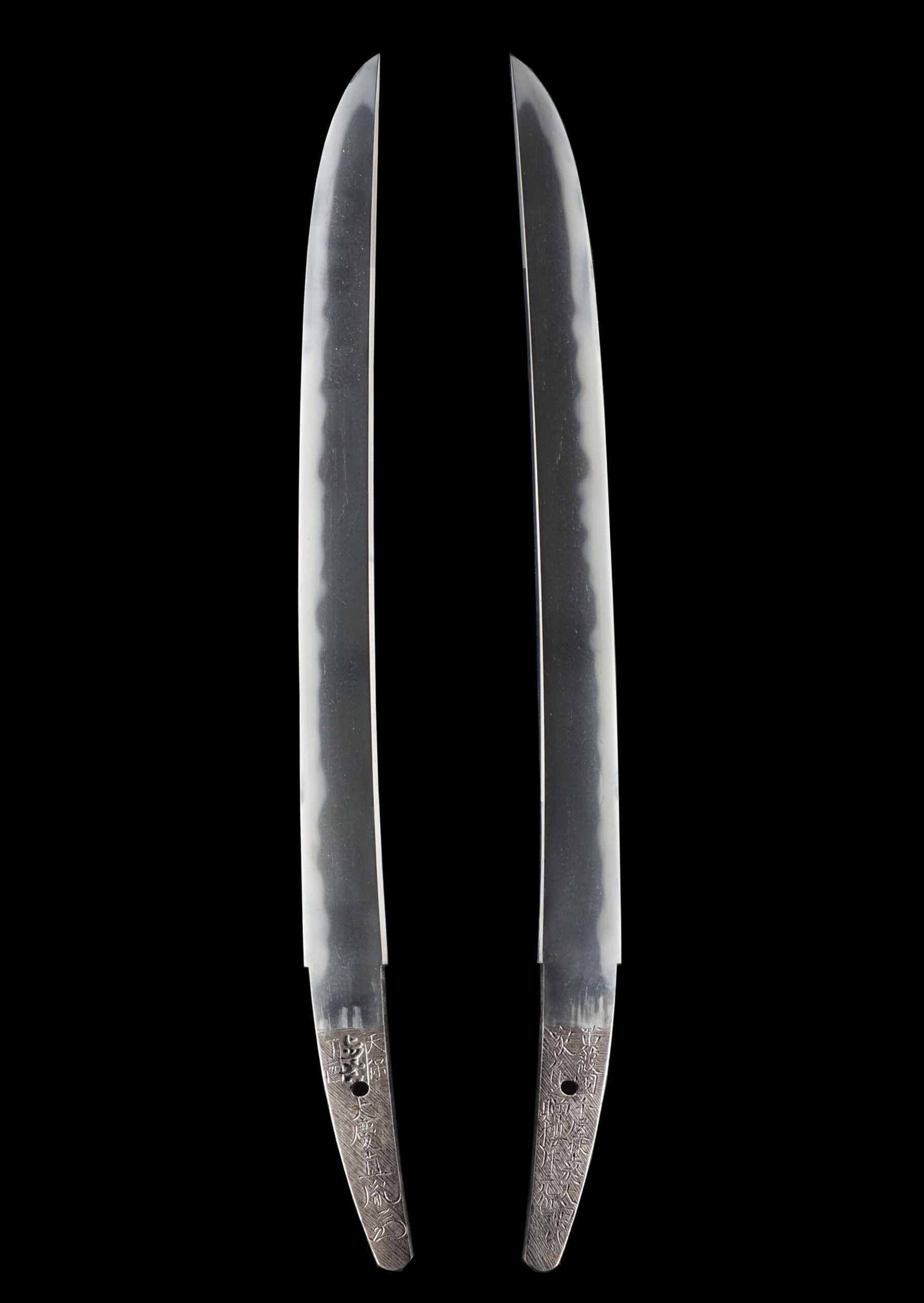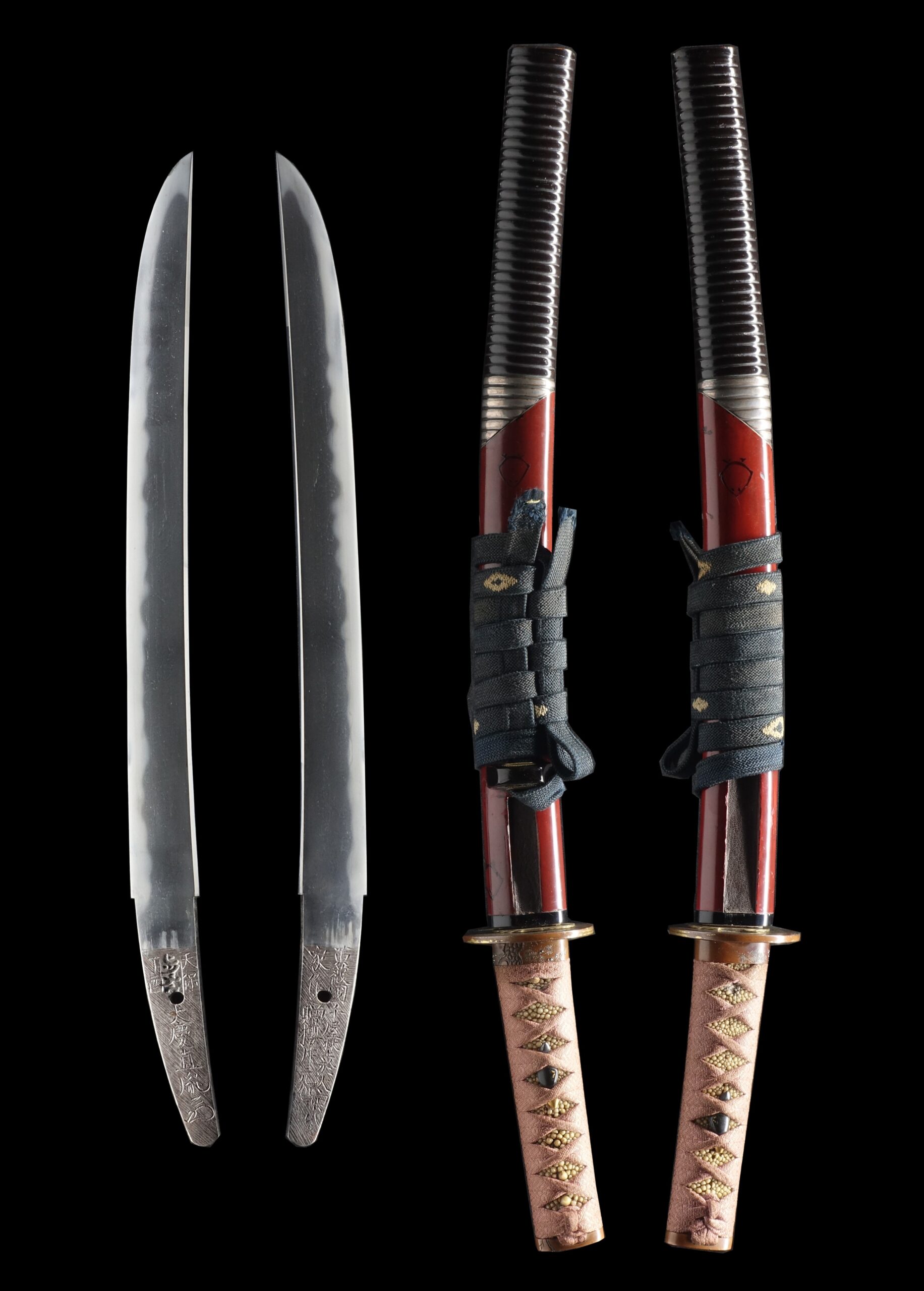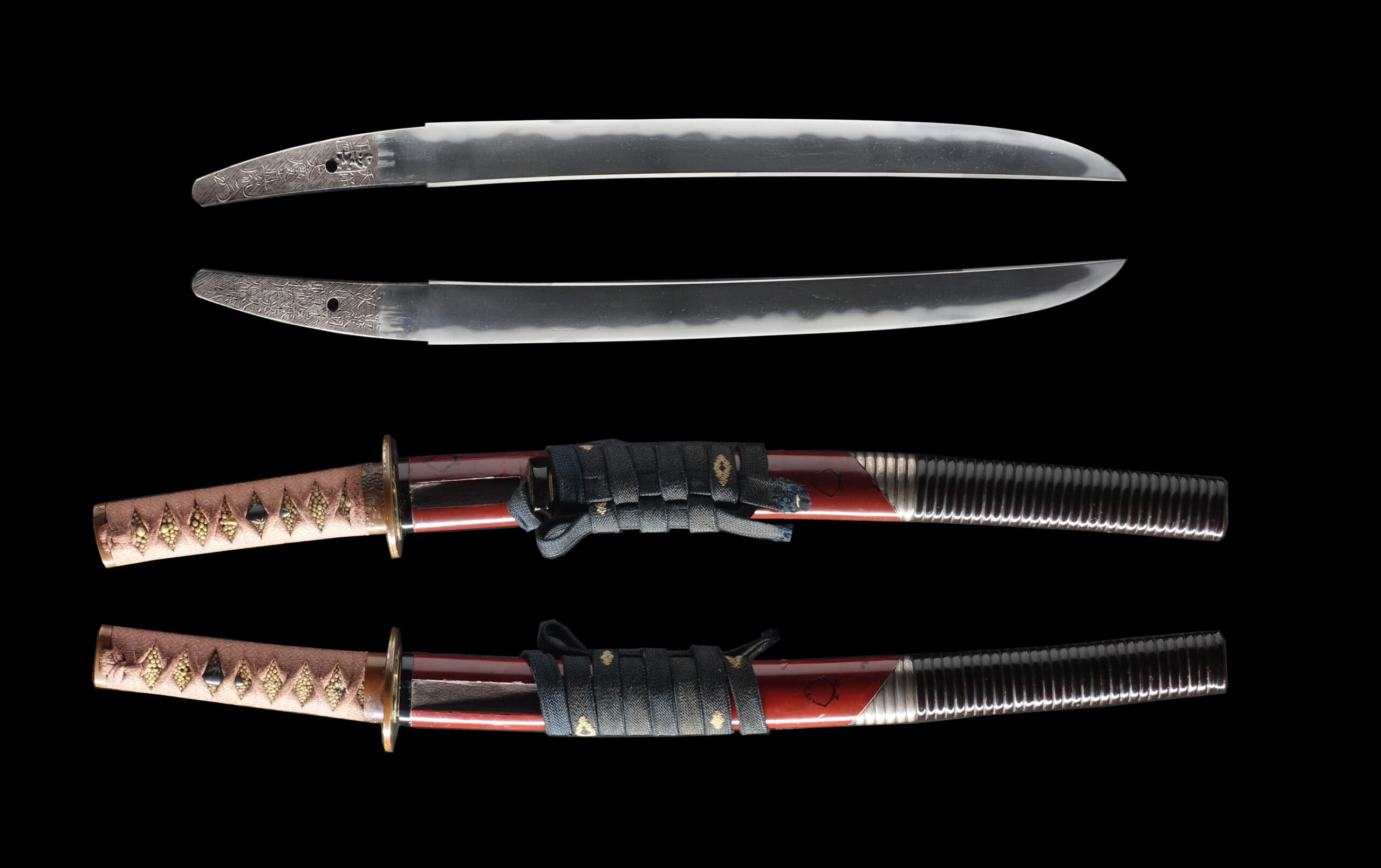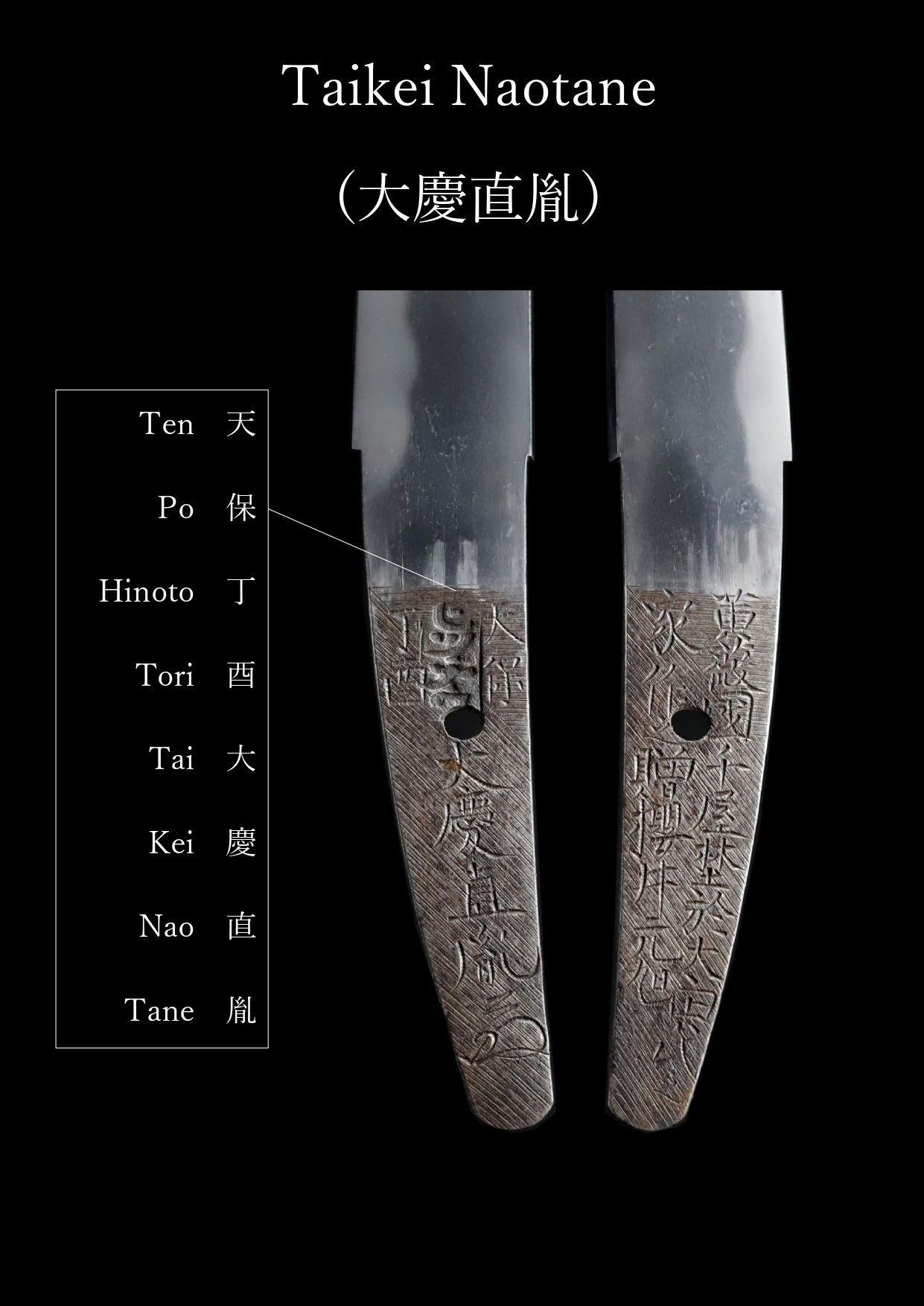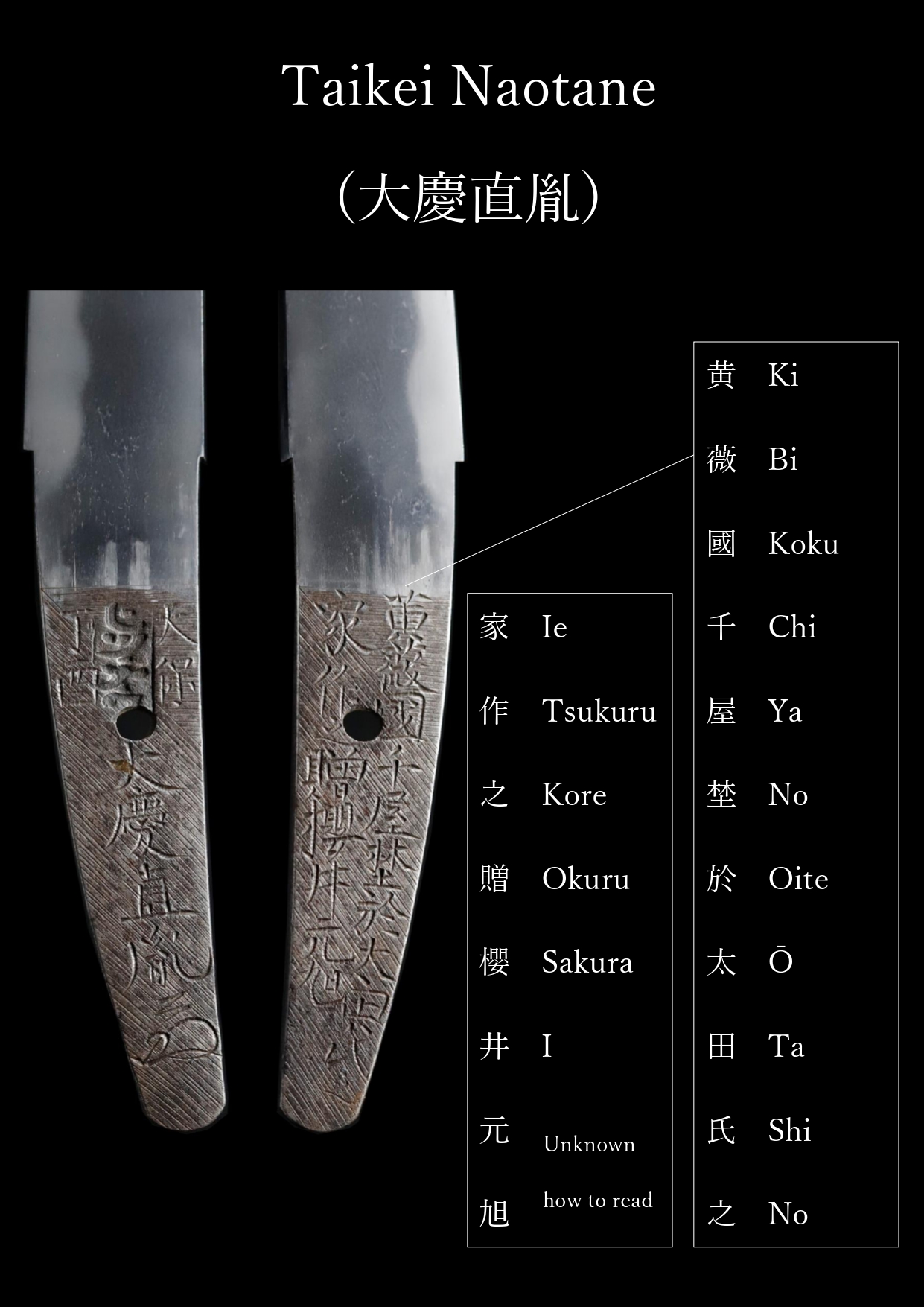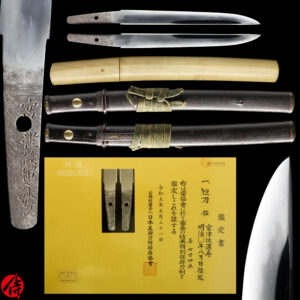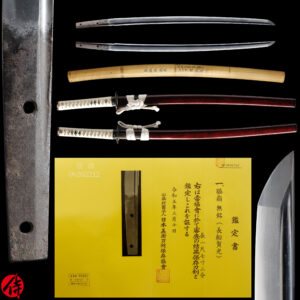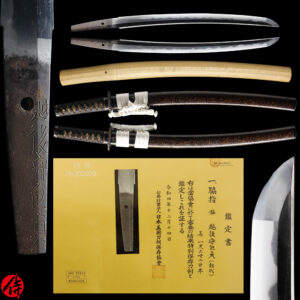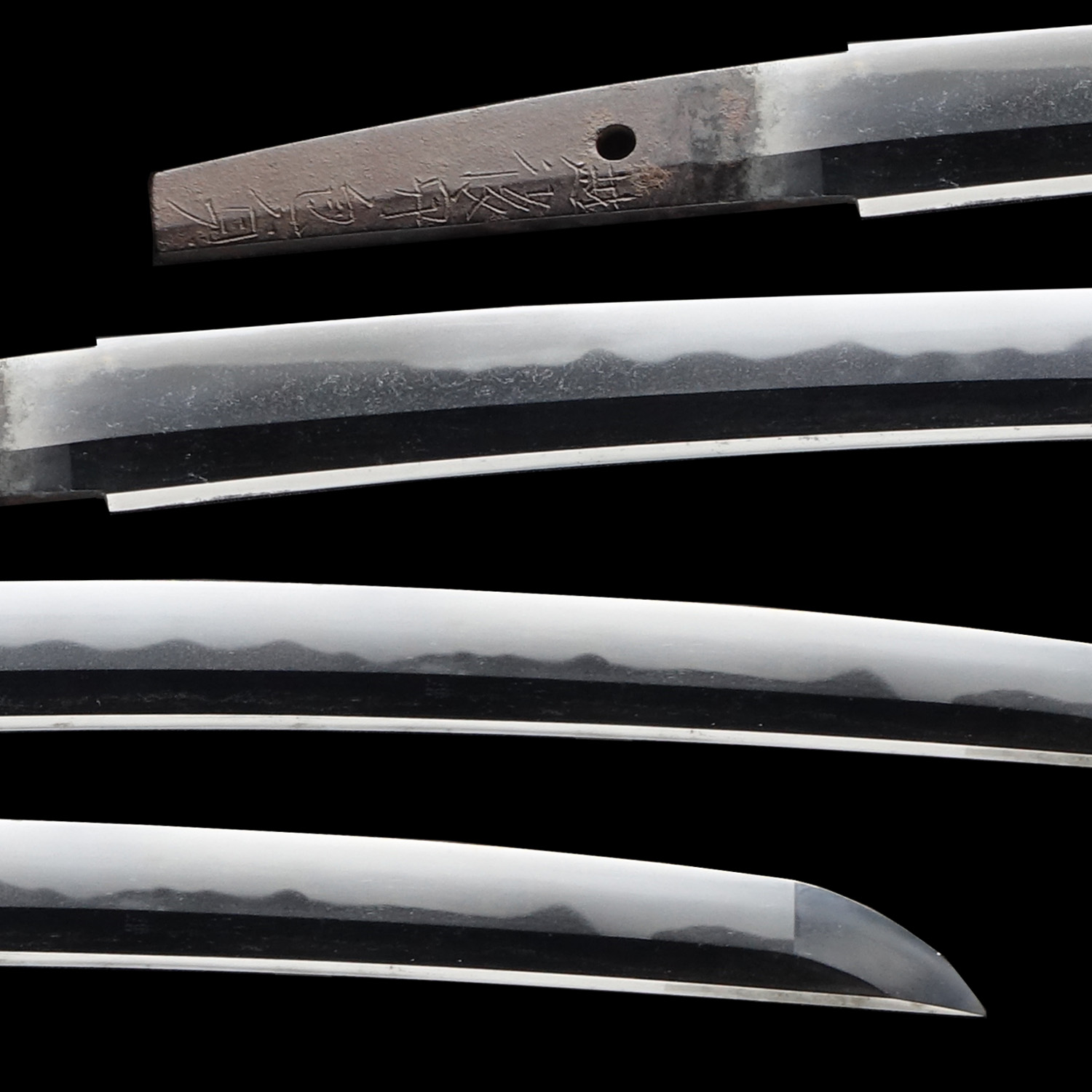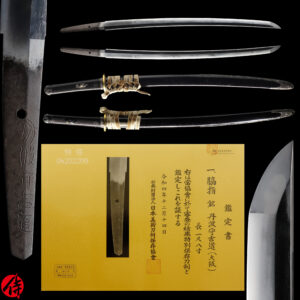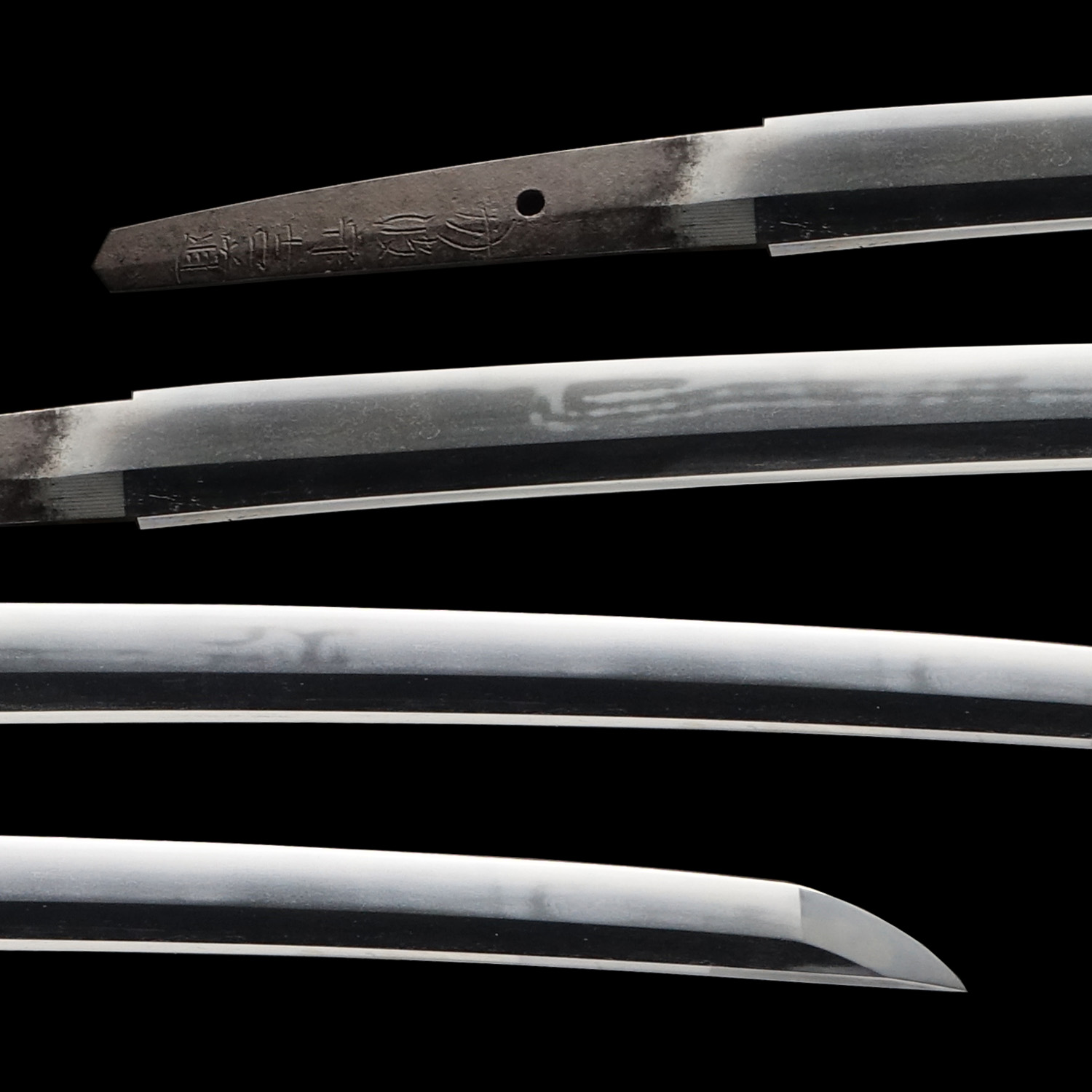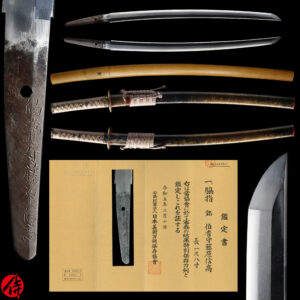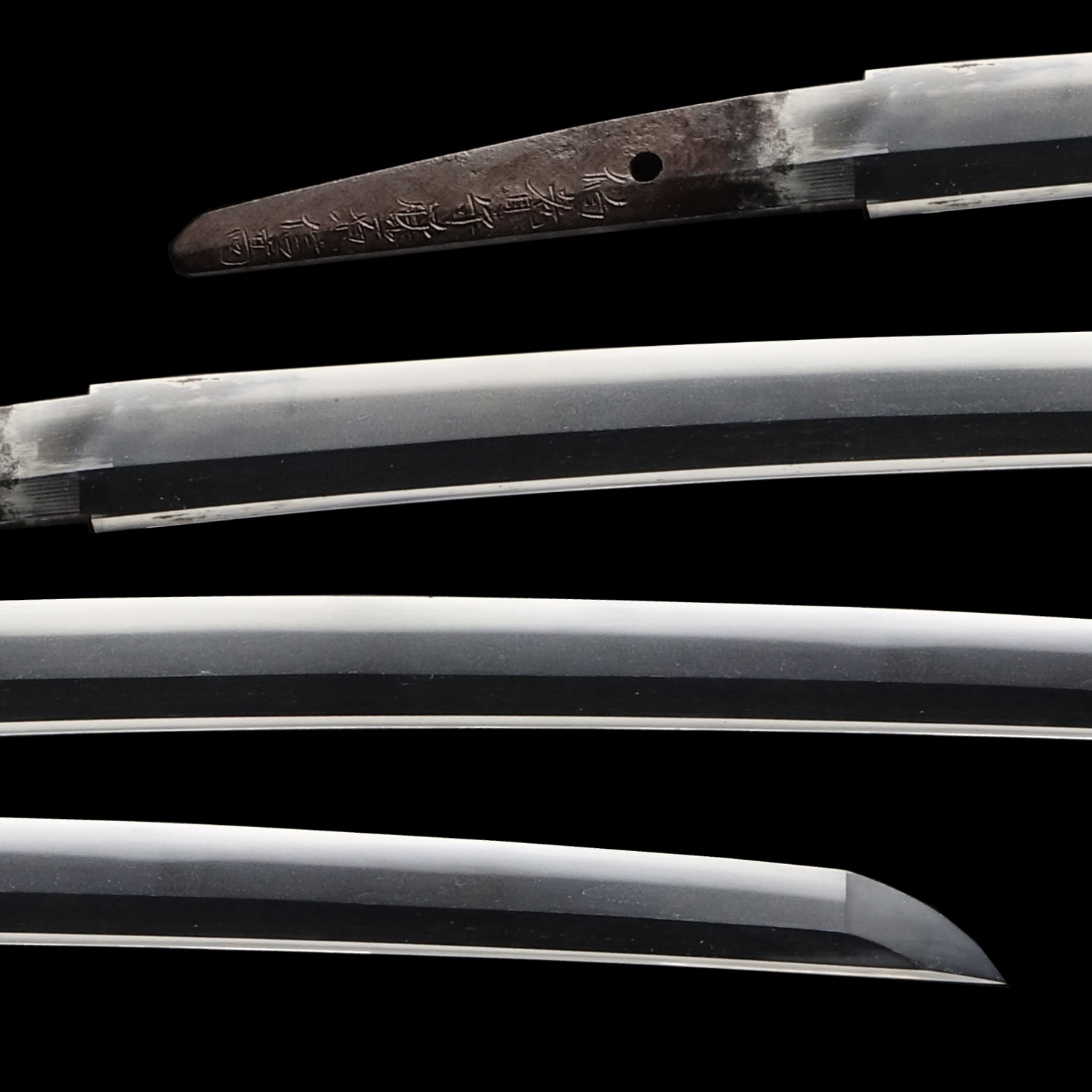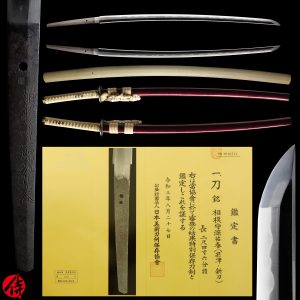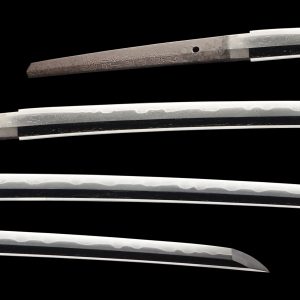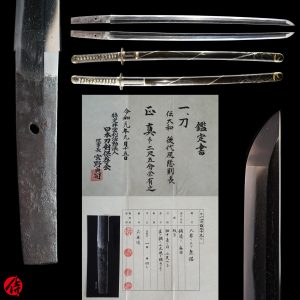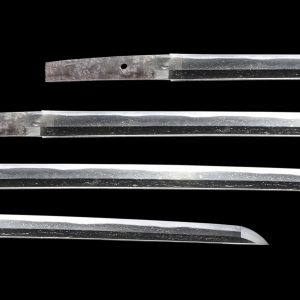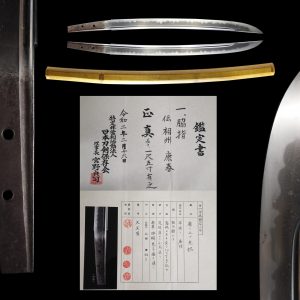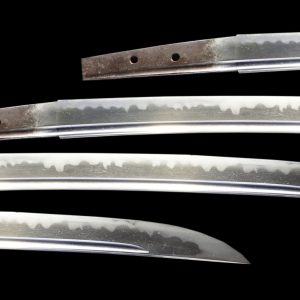Antique Japanese Sword Wakizashi Signed by Naotane with NBTHK Tokubestsu Hozon Certificate
【Description】
Summary
This blade was signed by Taikei Naotane (大慶直胤) in the 8th year of the Tenpo era (1837). Based on the inscription on the tang, it was made in Senyano village, located in Kibikoku (today’s Okayama prefecture). And this blade was a gift for 桜井元旭. Taikei Naotane is considered one of the three most renowned swordsmiths during the late Edo period. The other two are Suishinshi Masahide and Minamoto Kiyomaro. Naotane is also known as Shoji Minobe (荘司箕兵衛), which was his birth name.
Natane was born in the seventh year of the Anei era (1778) into a family that made sickles, a farming tool, for living in Dewa Koku (Today’s Yamagata prefecture). From a younger age, he got interested in becoming a swordsmith while learning blacksmithing skills. During the late Kansei era (1789-1801), he left his hometown and moved to Edo City to become an apprentice for Suishinshi Masahide, one of the most reputable swordsmiths in Edo during that time. He learned excellent craftsmanship from Masahide in a house owned by Akimoto family, which was the head of Dewa Koku.
It is said that Naotane became an independent swordsmith in 1801. He started to serve Akimoto family in 1812 through the introduction from Suishinshi Masahide. And he received the honorable official title of Chikuzen Daijo (筑前大掾) in 1822. In 1848, he visited Kyoto and forged a Tachi blade for Takatsuka family, one of the imperial lineage, and received another title called Minosuke (美濃介). The more Naotane gained fame, the more often he was invited by a feudal lord or high-class Samurai in other provinces to forge blades. He created swords nationwide in his late career.
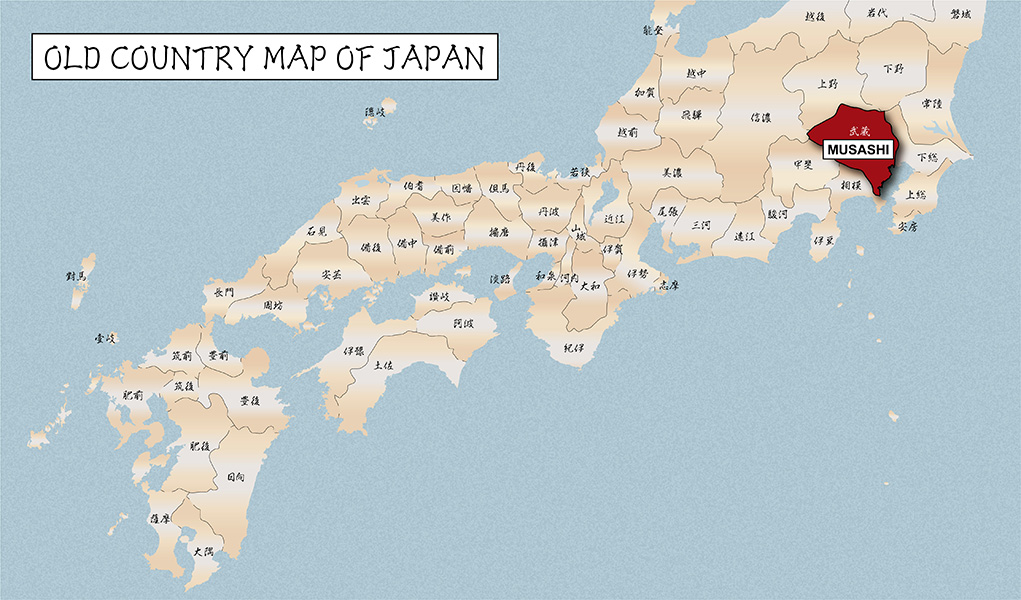
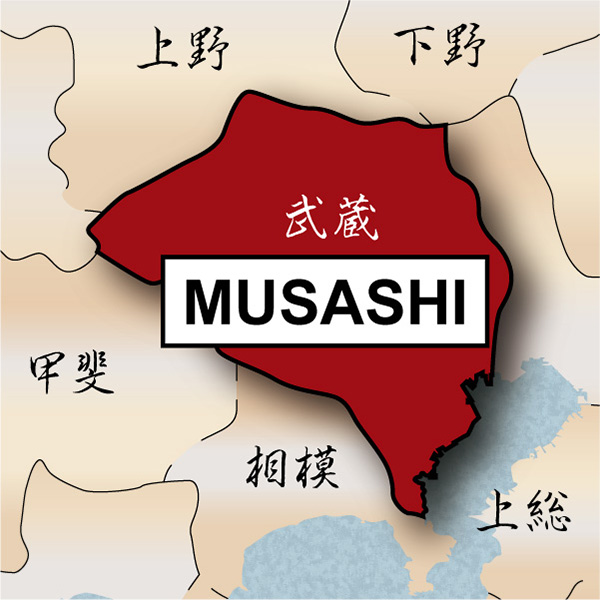
The works of Naotane have been highly appreciated because he played an essential role in Japanese sword history at the end of the Edo period. It is said that he mastered all the five Japanese sword traditions called Gokaten (五箇伝). They are Bizen DEN, Mino Den, Soshu Den, Yamashiro Den and Yamato Den. It is said that he was especially excellent at Bizen and Soshu Den.
His master, Suishinshi Masahide, was the proponent of revitalizing old sword-forging traditions. This movement is called Token Futsuko Ron (刀剣復古論). Naotane followed suit and mastered superb craftsmanship. Natotane trained many famous swordsmiths, and one of them was Jiro Taro Naokatsu, who was active during 1805-1858. Naotane died at the age of 79 in 1857.
Sunnobi Tanto (寸延び短刀)
In Japanese sword terminology, this blade is categorized as a Wakizashi because its cutting edge length is more than 30 cm long. However, it is much shorter than the average Wakizashi sword. And it is very close to the Tanto sword. This Tanto is called Sunnobi Tanto, a Wakizashi sword whose cutting edge is very close to the category of Tanto (Cutting edge less than 30 cm). And it must have been used as a Tanto back in the day.
*Its Koshirae is a Wakizashi size.
This blade is appraised as a Tokubetsu Hozon Token(特別保存刀剣) issued by NBTHK(Nihon Bijutsu Touken Hozon Kyokai:日本美術刀剣保存協会). This authentication paper was only given to authentic Japanese swords, especially well preserved and high quality with artistic value.
【Blade】
Cutting Edge Length(Nagasa): 32.2 cm ( 12.7 inches)
Curvature(Sori):0.4 cm (0.16 inches)

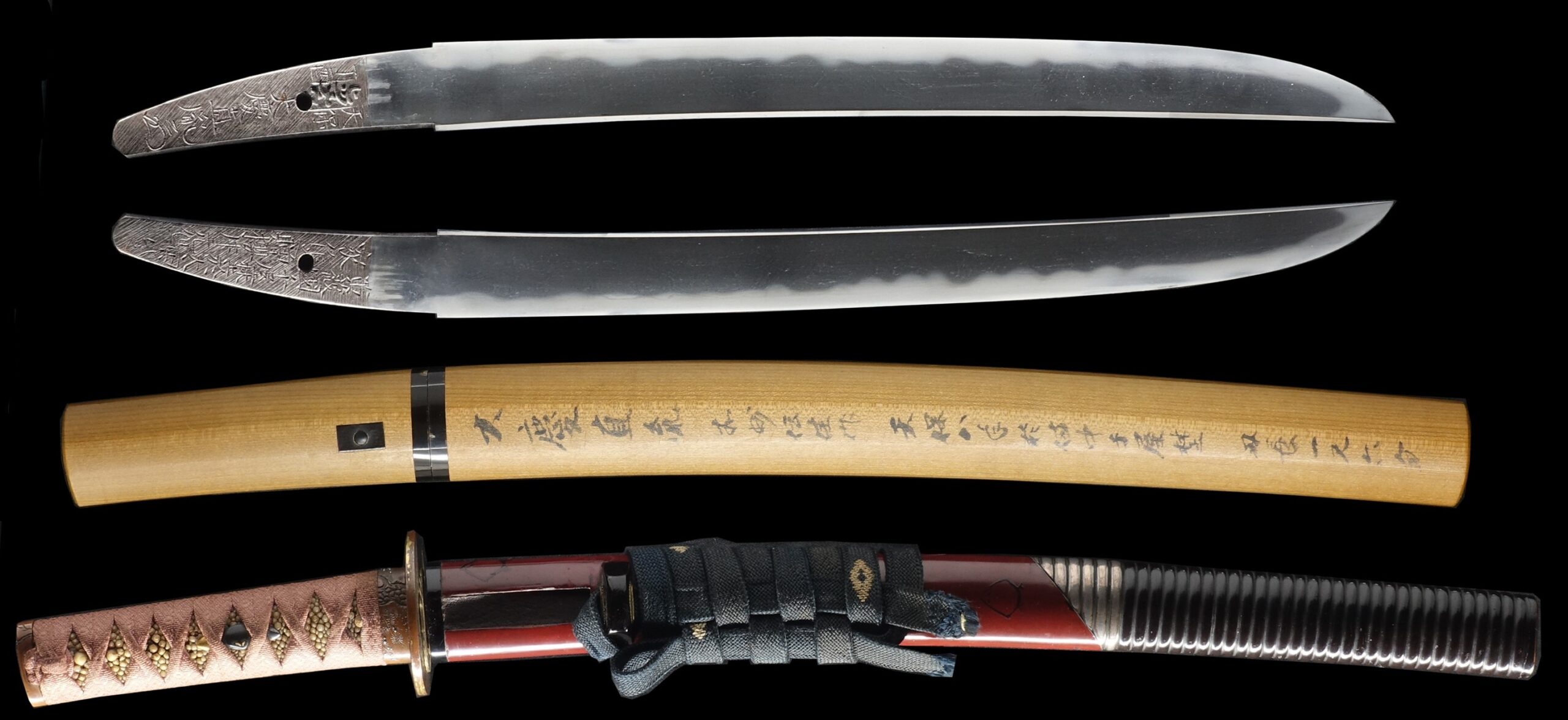
Hamon:
The crystalline structure which forms along the cutting edge of a blade as a result of the hardening process
Jimon(Jihada):
visible steel surface pattern created by folding and hammering during forging process
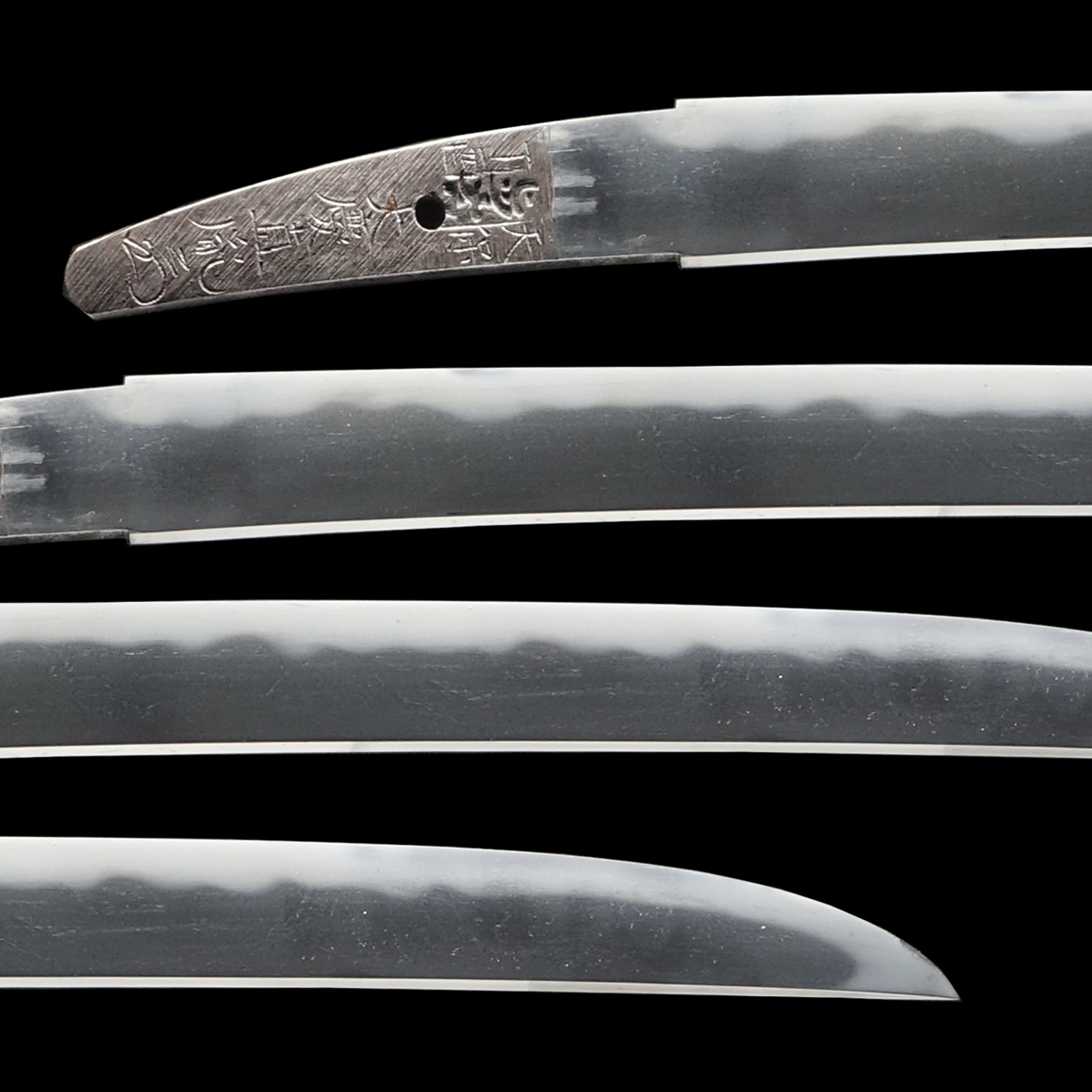
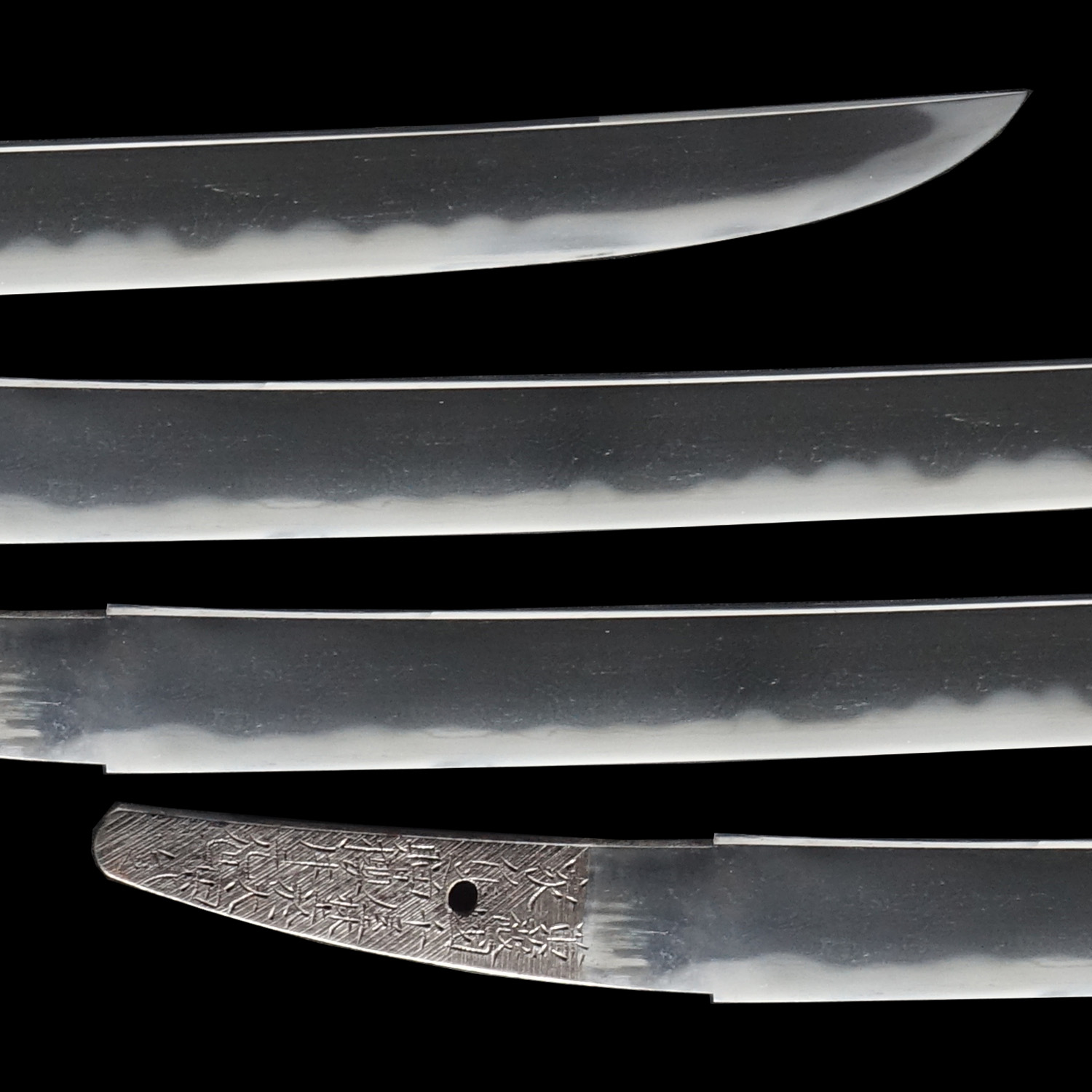
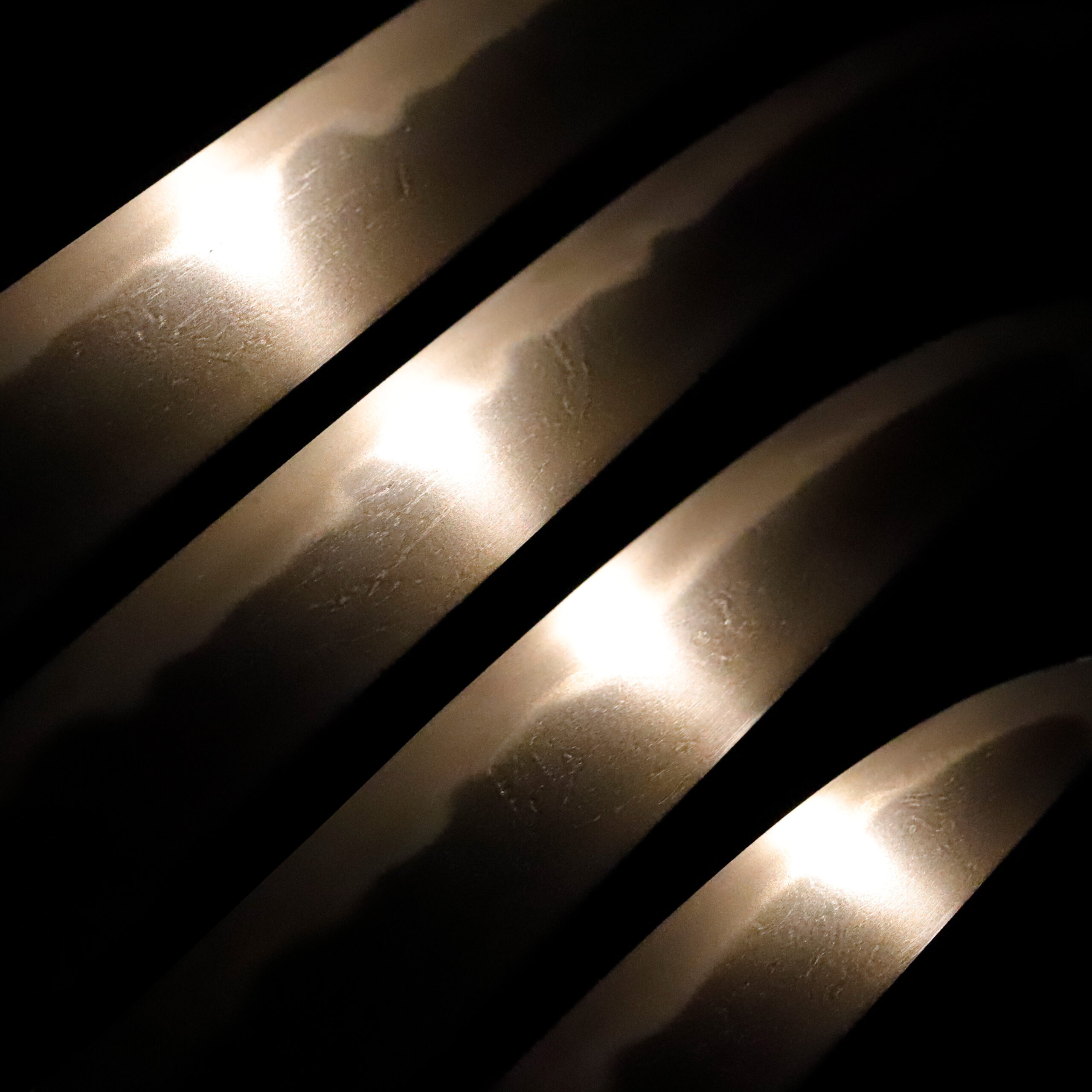
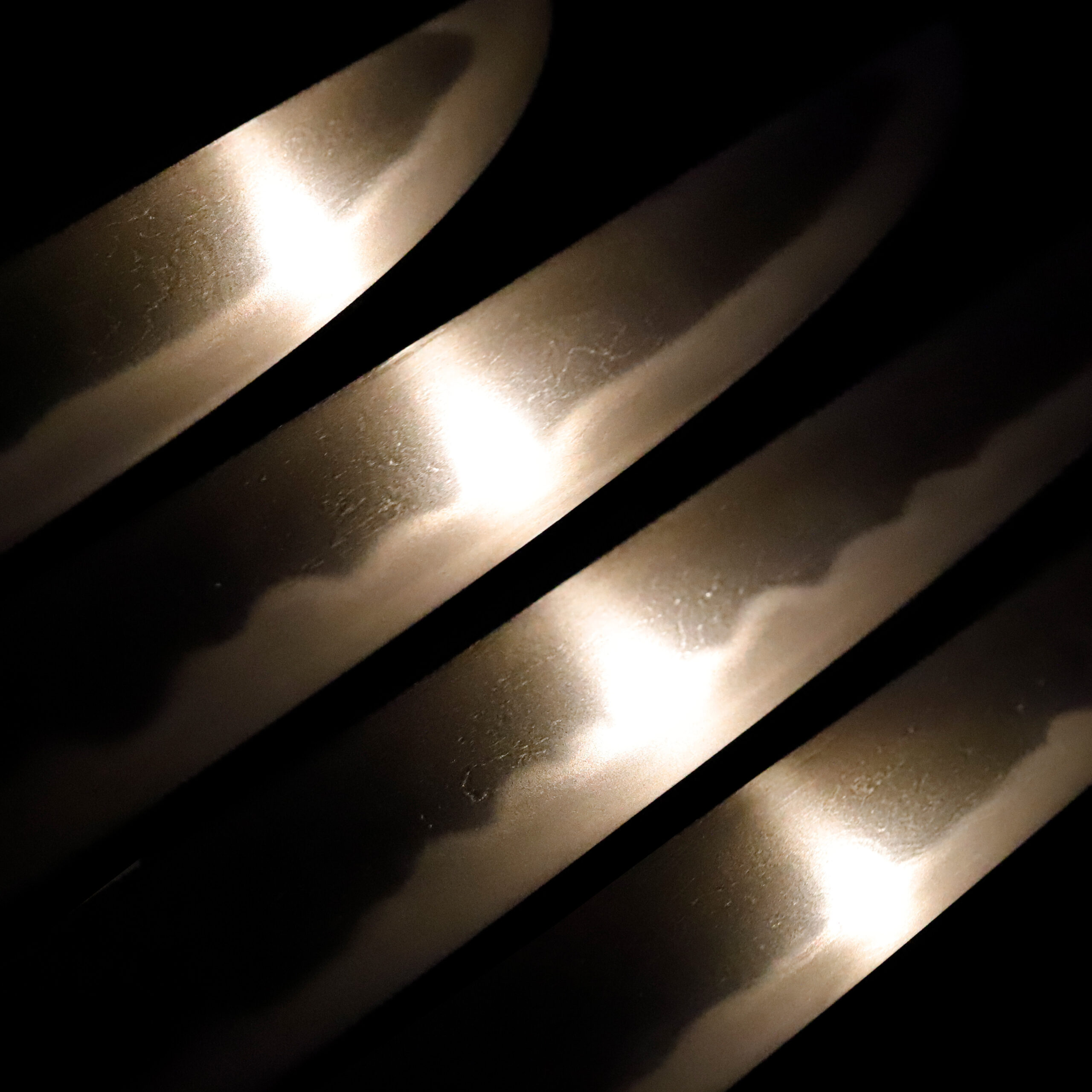
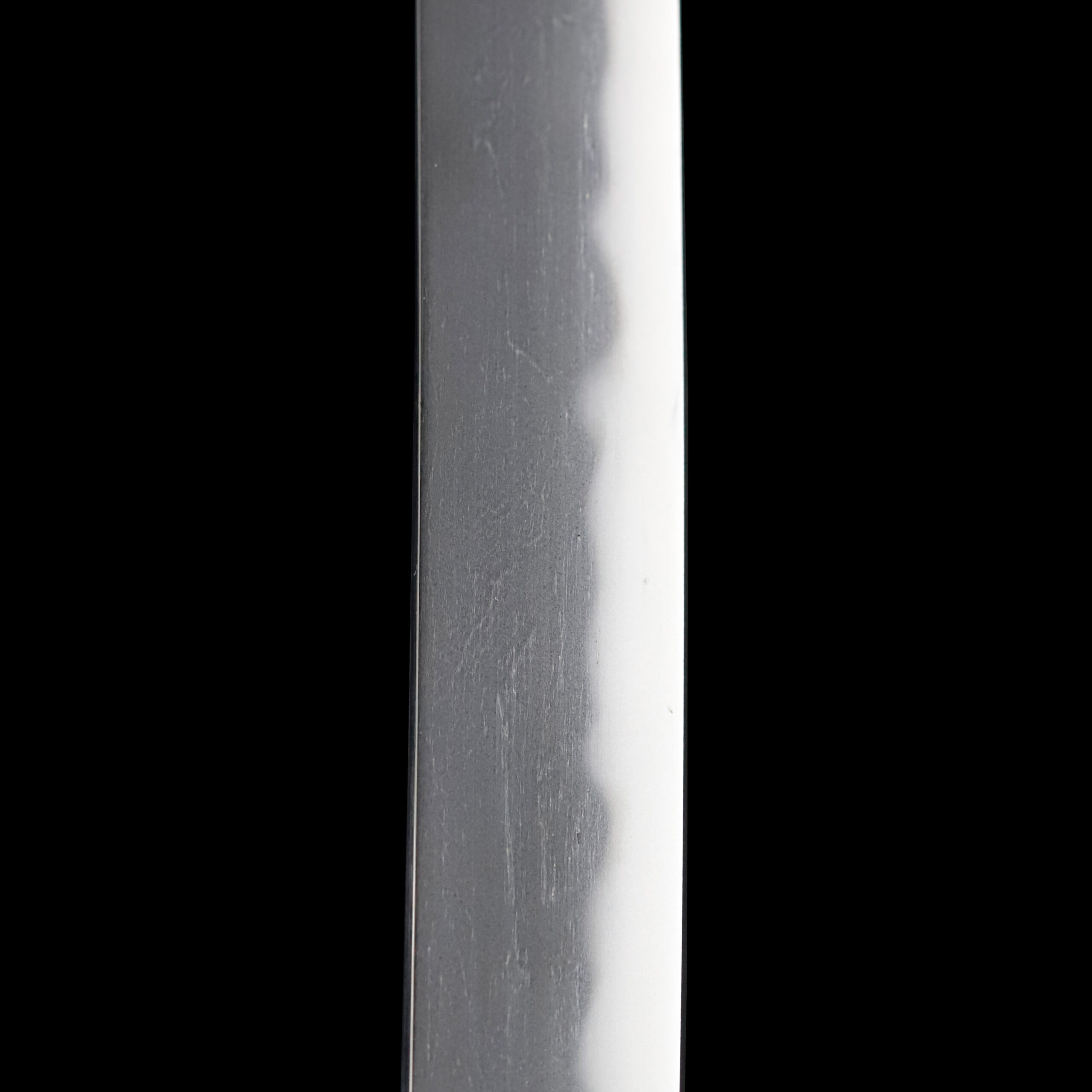
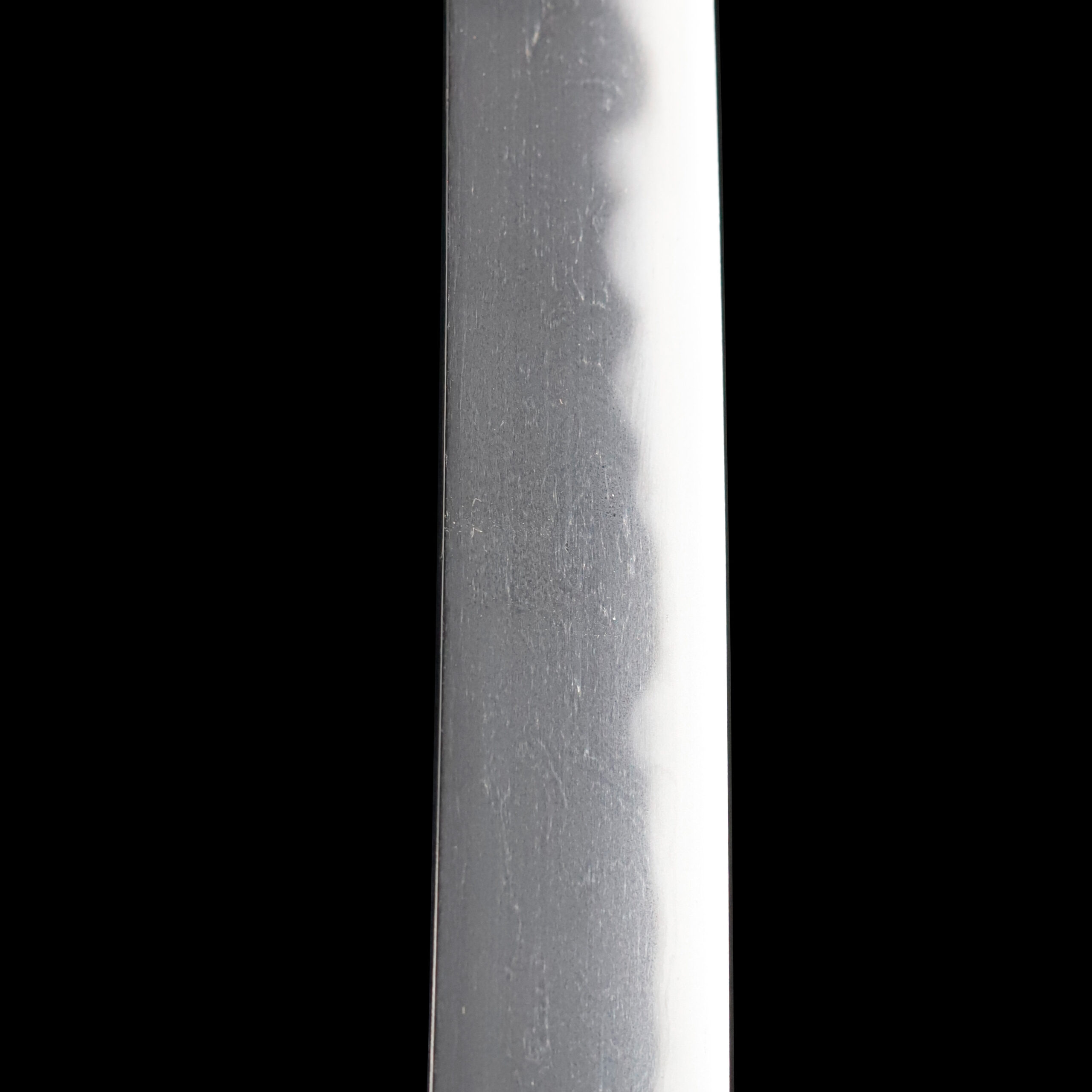
Nakago:Nakago is the tang of the Japanese sword.
Japanese swordsmiths left the black rust on the tang because it prevents red rust while the tang is in its handle. And the discoloration of the tang was created over time, and it is a great indicator for a Japanese sword specialist to estimate when the sword was forged.

Koshirae: Koshirae is the mounting of the Japanese sword. There are several parts that consist of Koshirae such as Saya(Scabbard), Tsuka( Handle), Tsuba(Handguard).
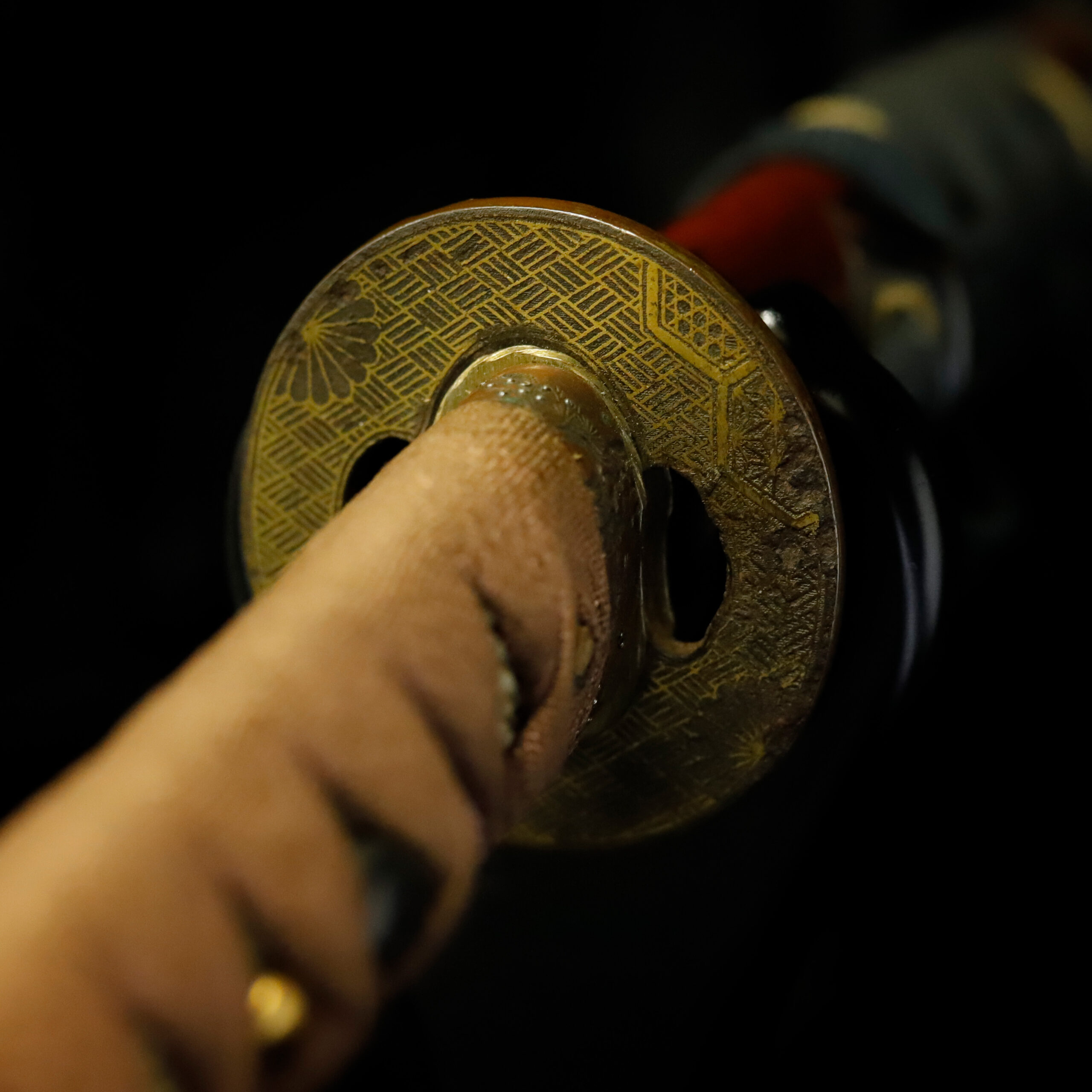
Fuchi-Kashira:A pair of matching sword fittings that cover the upper and bottom parts of its sword hilt.
This work makes good use of the color of the copper material. About the design, we could find several plant motifs: Ume (梅, Japanese apricot blossom) and Matsu (松, pine tree), and both are auspicious plants. In Japan, there is a good omen design called the Shou Chiku Bai (松竹梅). It is a combination of pine trees, bamboos, and Japanese apricot blossoms. These three plants grow splendidly even during the cold winter months, so they are used as a symbol of auspicious things, to represent bright things, to decorate wedding reception seats, and to decorate Kadomatsu during New Year’s holidays, etcetera. Their vitality and perseverance, which remain beautiful even in the harshest of cold weather, appealed to the spirituality of the Samurai and might have been favored.
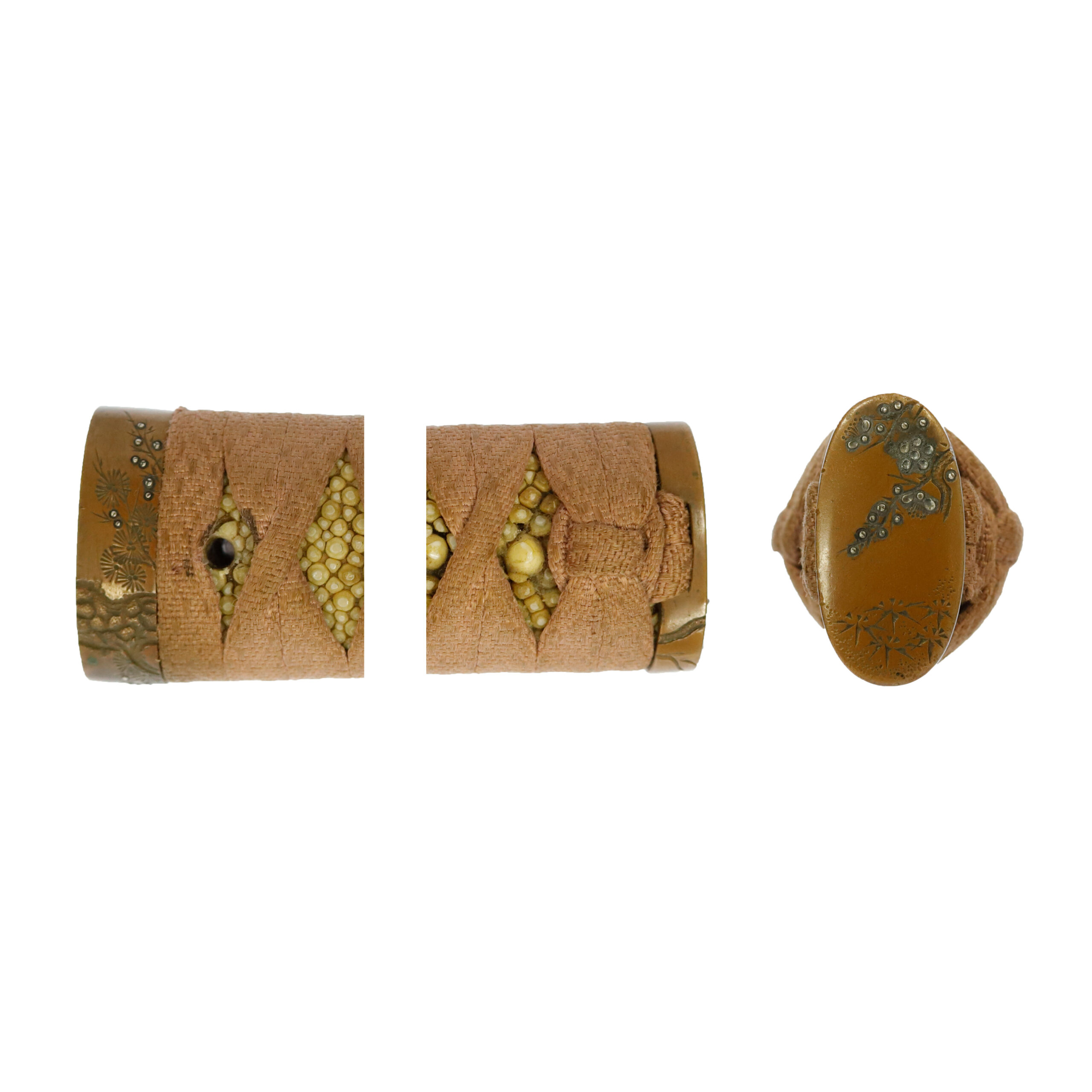
Tsuka and Menuki:Tsuka is the handle of the Japanese sword and Menuki is its decoration.
This Menuki’s motif is a combination of seashells. In the Heian period, the Kaiawase (貝合わせ, a game that uses clams) became popular among aristocrats. Each clam matches only with its pair shell. Therefore, people consider that the clam pattern represents a happy marriage. It is said aristocracies once brought the kit of the Kaiawase as their trousseaux.
From another point of view, we could guess that the seashell motif has been familiar to Japanese people because of the geographical situation of Japan. Japan is an island, and several seas surround it. Therefore, the shipping industry is thriving, and seafood has been one of the essential food sources. From such a situation, we think that the seashell design was favored by many Japanese people, of course including Samurais.
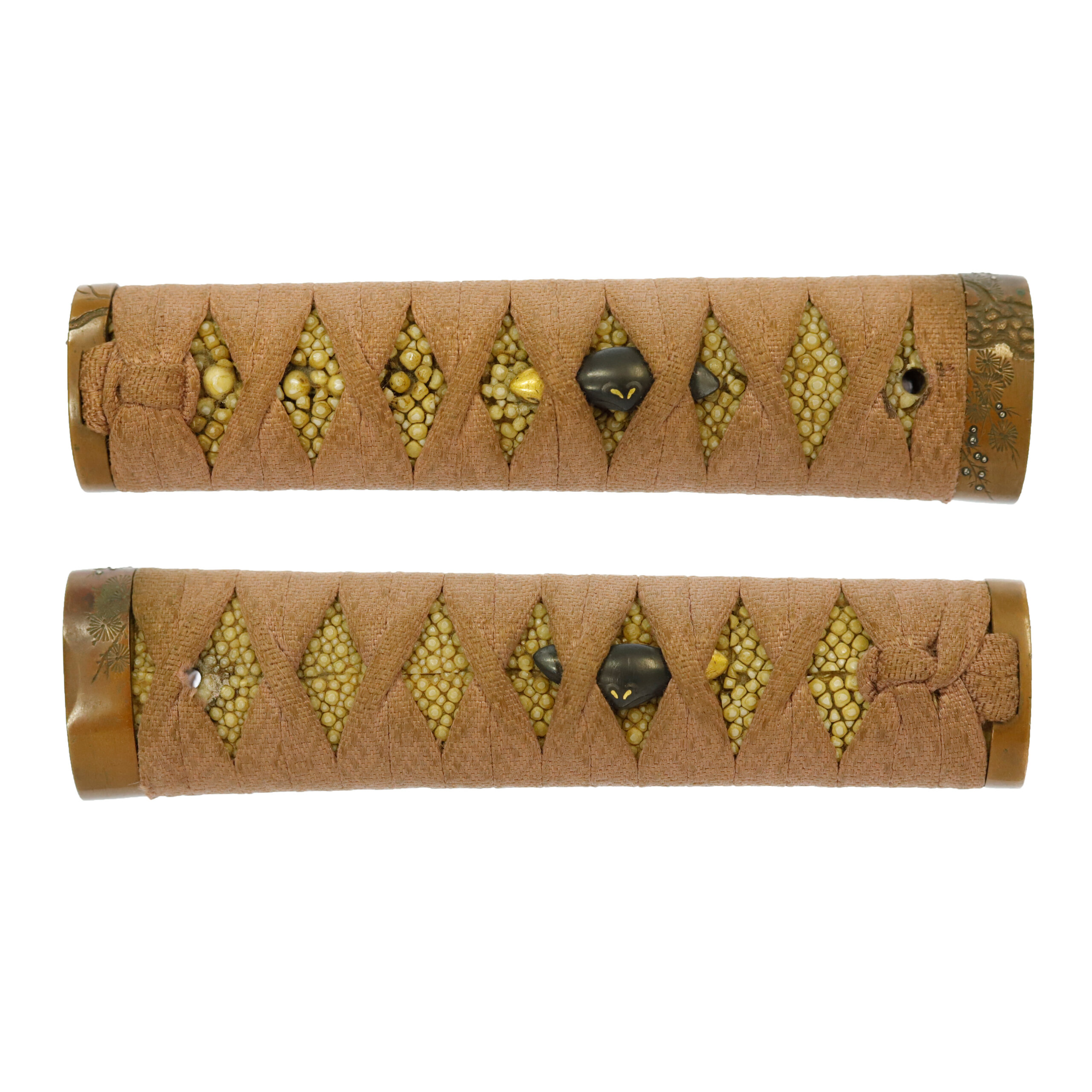
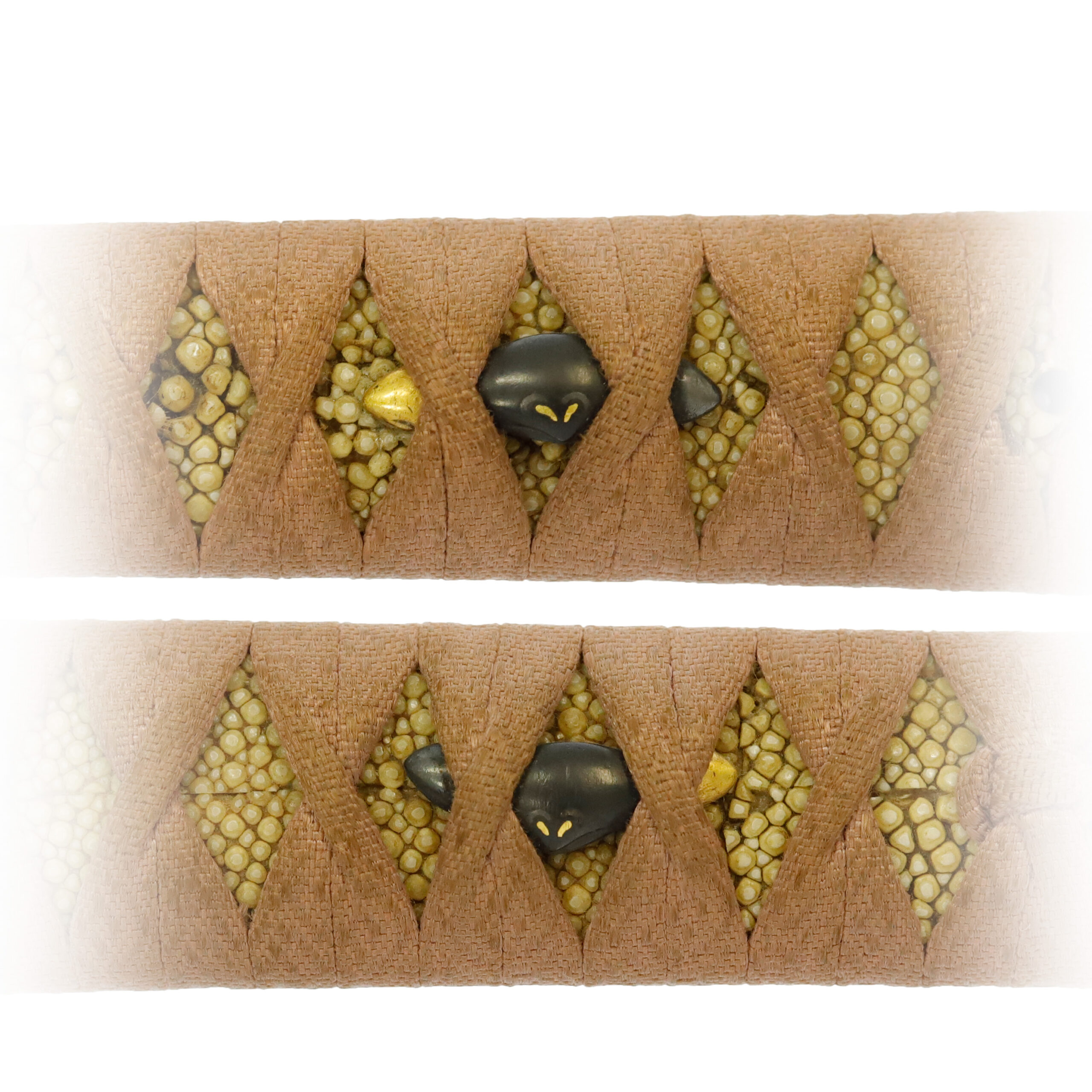
Tsuba and Habaki:Tsuba is the handguard for the Japanese Sword and Habaki is the equipment to make the blade not touch its scabbard inside. It prevents the blade from getting rusty and chipped.
This Tsuba has a gorgeous look. Several geometrical patterns are designed on this Tsuba, and we assume brass or gold inlay is used for making these patterns. We would like to take a look at some of the patterns designed. The Kikkou Mon (亀甲文) is a continuous geometric pattern connecting regular hexagons up and down. According to a theory, this design was brought from the continent in the Asuka (592-710), and Nara period (710-794). A proverb says turtles live long lives; therefore, turtle and turtle shell patterns represent longevity. In addition, as this continuous hexagonal pattern does not get out of its shape, it is said people wished for eternal prosperity by using this design. When this design was brought to Japan, it was monopolized by the aristocracy so that ordinary people even could not see it. It was such a prestigious design at that time. The Kikkou pattern was applied to various items such as Kimono (着物, traditional Japanese costume), Obi (帯, belt for Kimono), porcelains, and etecetra. Samurais started using the Kikkou pattern in the Kamakura period (1185-1333), and it has become widely known among the general public.
The Hanabishi (花菱) pattern is generally a combination of four petals. This flower-shaped pattern has been loved since ancient times thanks to its elegant appearance. This symbol might have been put here to show the family crest of the Samurai who owned this sword.
The Asanoha (麻の葉, hemp leaf) design is a geometric pattern with hemp leaves as a motif combined with a regular hexagon. A triangle shape has been thought to have the power to protect people from evil spirits. Therefore, the hexagon shape, made of triangles, has been regarded as an amulet with more substantial power. Since hemp grows fast and has strong vitality, this plant pattern was often designed for children’s birth clothes wishing for their health and growth. Also, the Asanoha pattern has been used to decorate Buddhist statues since the Heian period (794-1185).
In this way, this Tsuba is decorated with various good-omen patterns. The previous owner of this Japanese sword might have been particular about these meanings.

Saya: Saya is the scabbard for the Japanese sword.
If you like to have a Kozuka for this Saya, please feel free to contact us.

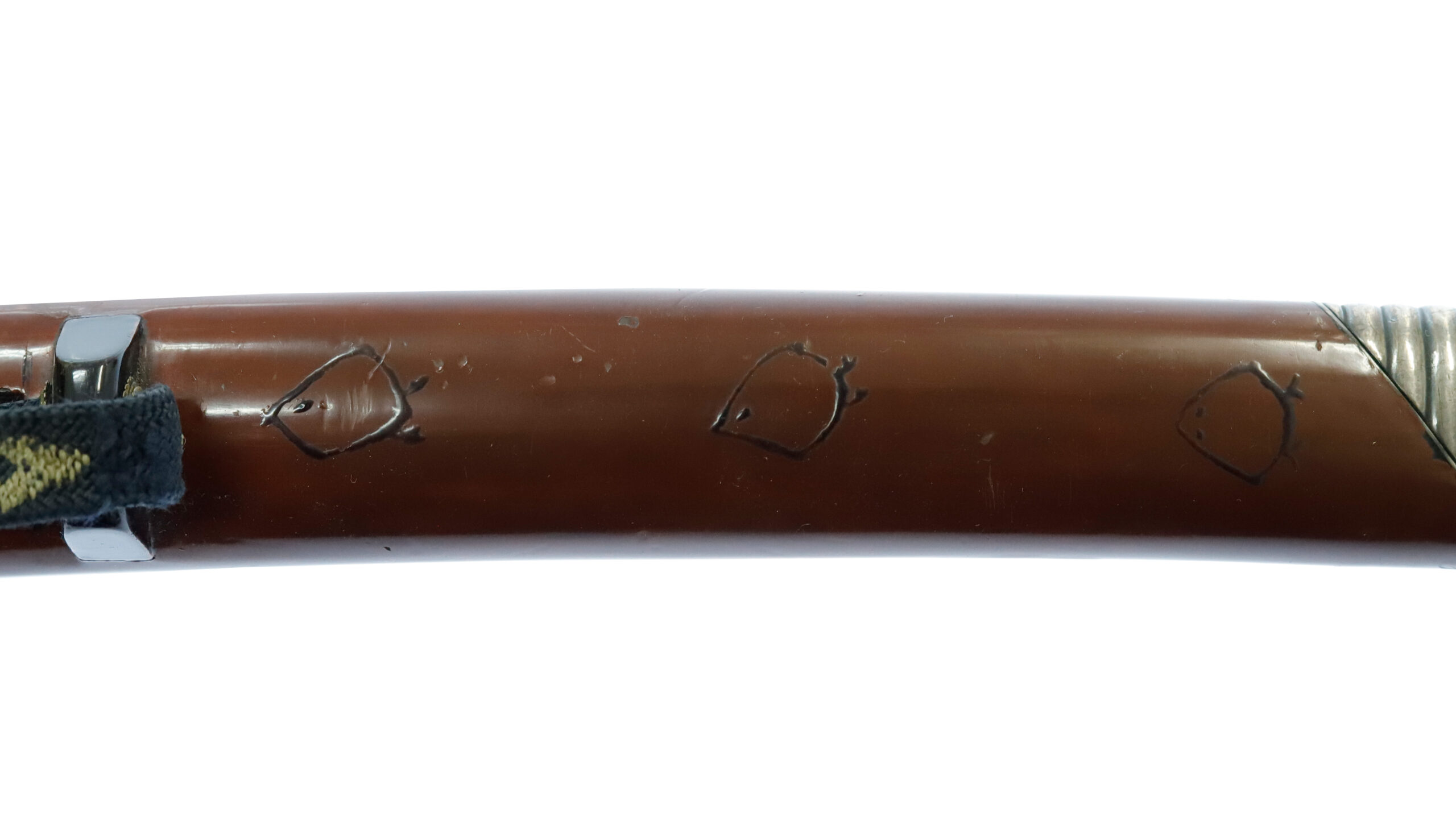
Authentication Paper:NBTHK Tokubetsu Hozon Certificate for the blade (No. 1012265)
NBTHK, also known as Nihon Bijutsu Touken Hozon Kyokai (the Society for the Preservation of the Japan Art Sword), is one of the oldest Japanese sword appraising organizations in modern-day Japan. They authenticated the blade on Dec 2nd in the first year of Reiwa (2019). They appraised it as Tokubetsu Hozon Touken, the blade especially worth preserving for Japanese society. The purchaser will receive this original certificate as well. We can also translate what is written into English and make a PDF file for your record if you request.
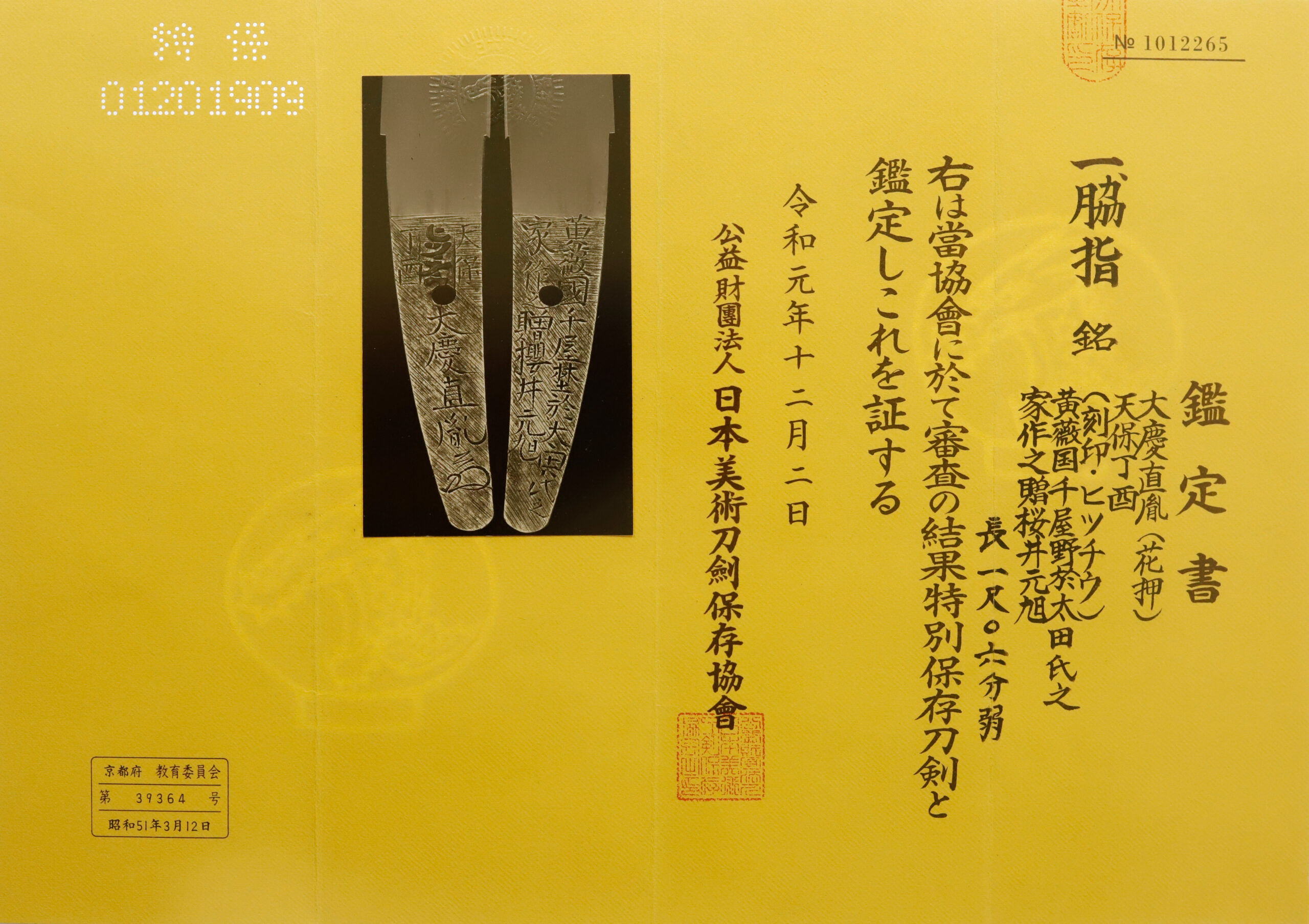
Registration Number : Kyoto 33364
The Board of Education in Kyoto prefecture issued a registration paper for this sword. It is called Jyu Token Rui Torokusho(銃刀剣類登録証). Bunkacho(The Agency for Cultural Affairs) acknowledges a Japanese sword with this paper as a work of art.
The sword needs to be traditionally hand-forged and made of Tamahagane carbon steel to be registered in the system. With this paper, its owner in Japan can legally own an authentic Japanese sword. Based on this registration number, we will apply for its export permit.
This paper will need to be returned to the board of education when the sword is being shipped abroad, but you can receive a copy of it. An English translation of this registration paper is available on request.
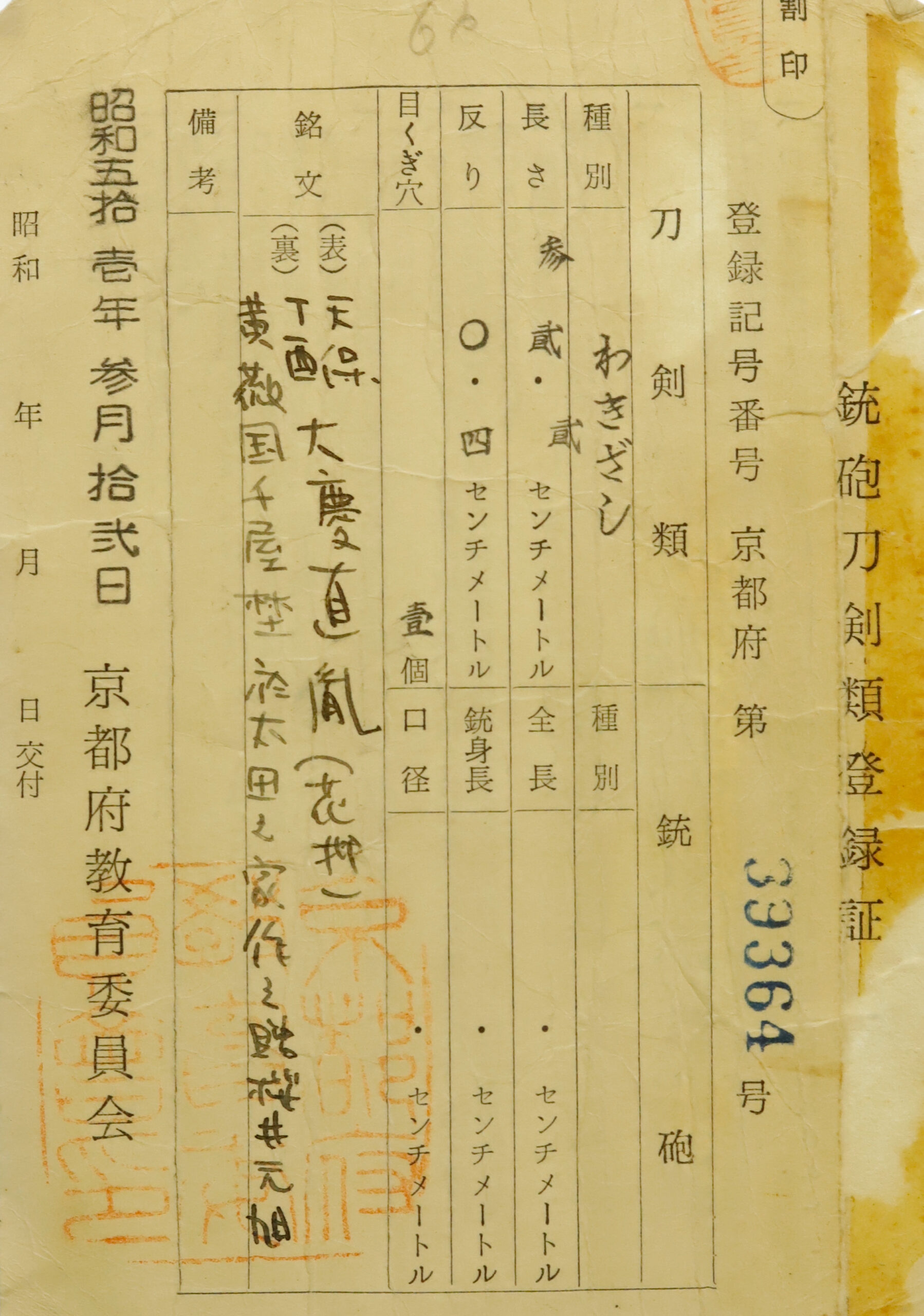

—————————————————————–
【About us】
Samurai Museum is located in Tokyo, Japan, exhibiting antique artifacts related to the Samurai history. Samurai Museum Shop is the place for those who are interested in Japanese culture and craftsmanship. We deal with antique Samurai swords/armor, traditional crafts made in Japan and so on.
【Japanese Sword& Export Process】
The Japanese swords we deal with are hand-forged edged swords made in Japan. It was made from the traditional carbon steel called TAMAHAGANE(玉鋼). Samurai Museum is familiar with the proper legal procedure for an antique/ authentic Japanese sword to be exported from Japan. We have sent more than 700 Japanese swords for the past few years (~2024) to amazing owners who appreciate its historical value.
Each Japanese sword is registered under the Agency for Cultural Affairs and the Board of Education in Japan. They issue a registration paper for each Japanese sword for its owner in Japan to legally possess it. The Japanese sword with its registration paper means it was traditionally hand-forged in Japan.
To legally export the sword from Japan to other countries, we will have to apply for its permit to the Agency for Cultural Affairs(Bunkacho) and return the original registration paper to the Board of Education. It normally takes around 2-4 weeks to receive this permit after submitting required documents. And we would like you to expect at least 1-1.5 months for your order to arrive at your given address after you ordered. For more detailed info, please click here.
It is allowed for residents in Japan to own authentic Japanese swords without a special license as long as they come with registration papers. Please feel free to contact us if you are a resident of Japan, whether temporarily or permanently. We will also assist you when you leave Japan and need to obtain the export permit.
【Payment Method】
We accept payment through Stripe (Credit card), PayPal, Apple Pay or ChromePay, all of which are secure payment methods. Also, you don’t need to make an account on Stripe for the checkout. If you prefer other payment method, please contact us. After confirming your payment, we will apply for an export permit. You may either pay in JPY, USD, AUD, CAD,EUR CHF or GBP. The price is set in Japanese Yen. Prices in other currencies are automatically calculated based on the latest exchange rate.

* If the amount is above 1 million JPY, Stripe or wire transfer will be the only options for payment.
【Shipping】
We have shipped authentic Japanese swords to the USA, UK, Canada, Mexico, Germany, France, Hong Kong, Finland and Australia. If you don’t live in these countries and like to order, please contact us first before making a purchase. We offer Free International Shipping as long as we can send antique Japanese swords by EMS.
We normally ship by EMS(Express Mail Service) provided by Japan Post. We will send you a tracking number for your order as soon as we hand it to the post office. We will put 100 % insurance on the shipping document without any extra charge. Based on the total amount, there might be a duty tax or other fee for you to pay, depending on the countries. We use package cushioning to protect the item and put it in a PVC pipe, which is one of the most secure packages because of its durability.
It will normally takes 5-14 days for the item to arrive at your given address after we dispatch it. Time of delivery is estimated as accurately as possible by the carrier but does not take into account any delays beyond our control such as by inclement weather, post office holiday seasons.
* If you live in Australia and like to purchase an authentic Japanese sword, please click here to know the detail.

【Review】
Here is one of the reviews we received from a customer who purchased an authentic Japanese sword from us. For more reviews, please click here.
“My experience overall with the whole process was wonderful. I had many questions about the history and process to purchase these treasures. All my questions were answered very timely and complete. The staff is very knowledgeable and very well versed if any questions do arise.”
【How to make sure the condition】
Please keep in mind that what you are going to purchase is an antique item. We uploaded high resolution photos for you to check its condition thoroughly. If you like to see more photos with different angles, please feel free to contact us. We will be happy to send them to you so that you can make informed decision. It is essential for us to know that you are happy with your choice of a sword. and we are prepared to use the best of our ability to serve you.
【How To Contact Us】
Please contact us through email, Facebook Messenger or Live Chat if you have any questions. You can find each icon on the right side of the website. Please click one of them to reach us. We will reply to you within 1-2 business days.
【The Art of Nihonto (Japanese Sword)】
Samurai’s history is a profound, eloquent legacy of ancient Japanese warriors in which millions of people worldwide are being fascinated. If you like to find out the art of Nihonto, please click here.
【A Guide to Japanese Sword Maintenance】
After acquiring an genuine Japanese sword, it is also important to know how to take good care of it. Here is the special video for you. Mr. Paul Martin, Japanese sword expert, shows you how to give proper maintenance to your sword. By mastering how to clean the Japanese sword, its aesthetic beauty will last forever.
When you purchase a Japanese sword from us, you can get a Free Japanese sword maintenance kit. It comes with four tools(Choji Oil, Uchiko Whetstone Powder, Peg remover, Oil Applicator). By watching the video instruction above , you can enjoy learning how to maintain your Japanese sword while appreciating it. If you have any difficulty assembling the sword or cleaning the blade, you can feel free to contact us.


MORE ANTIQUE JAPANESE SWORD FOR SALE
SWORDS WITHOUT CERTIFICATES FOR SALE
LEARN JAPANESE SWORD TERMINOLOGY
Thank you for reading all the information on the page. If you have any difficulty choosing the right Japanese sword for you, we will be more than happy to help you find the one that speaks to you the most. Please feel free to contact us.
